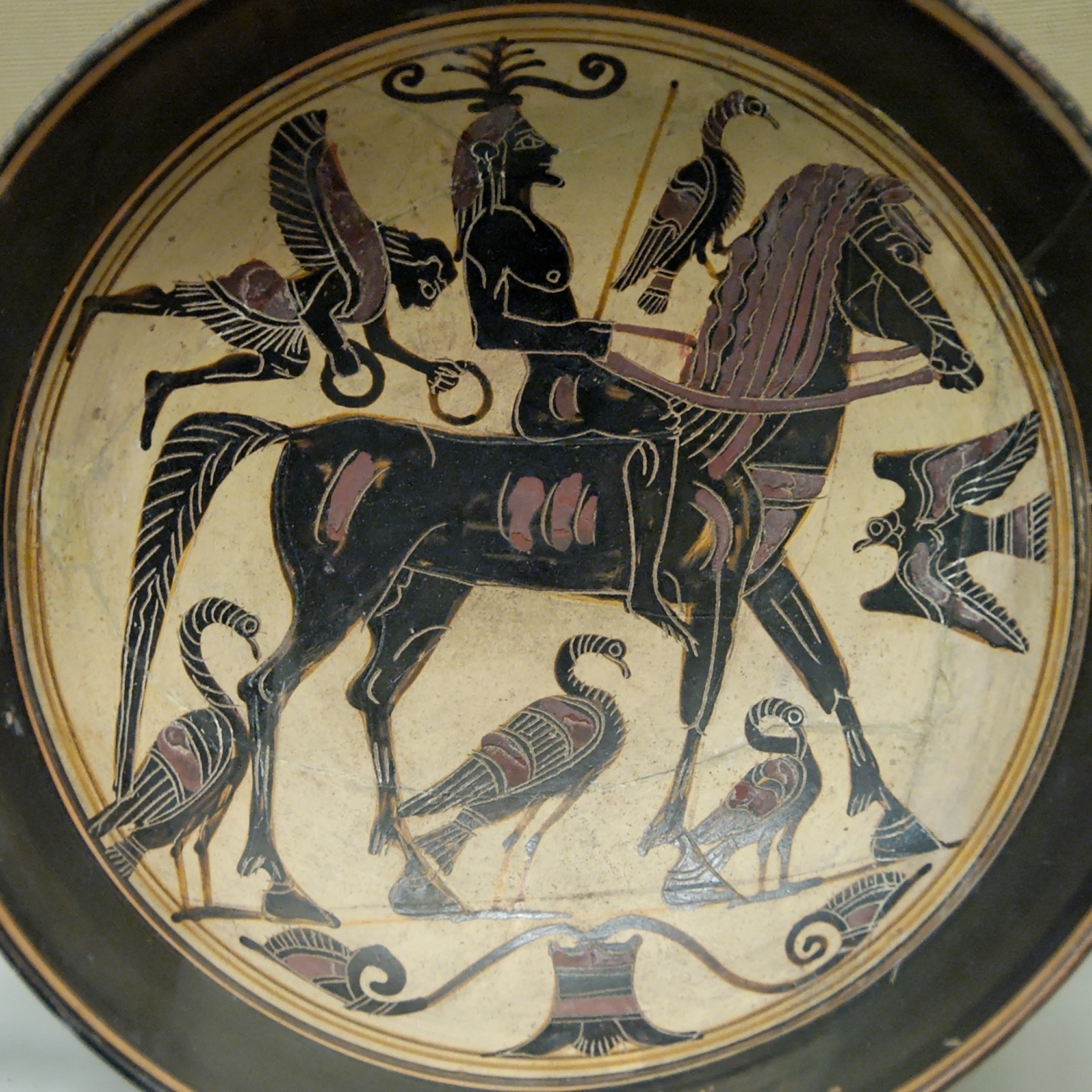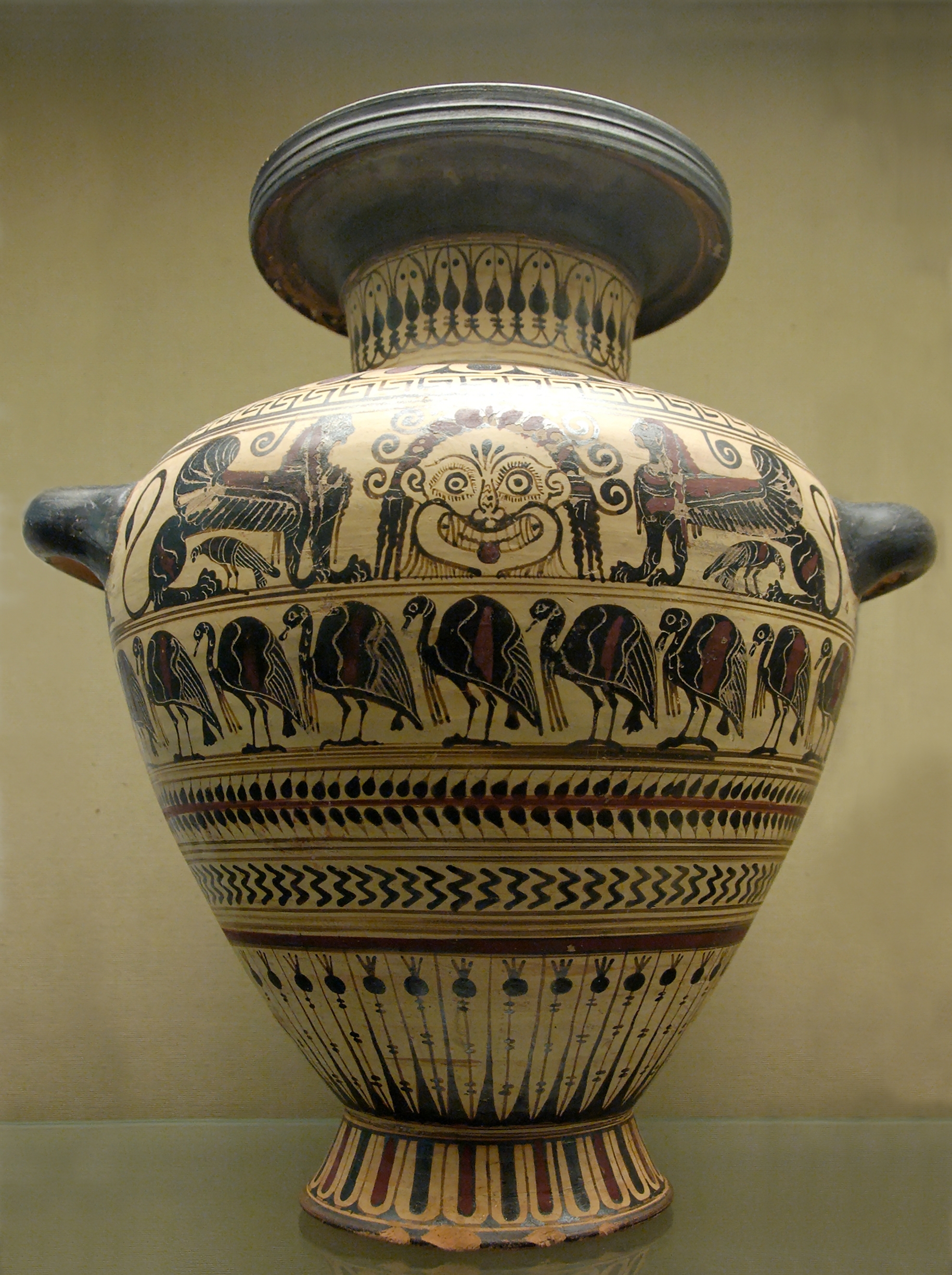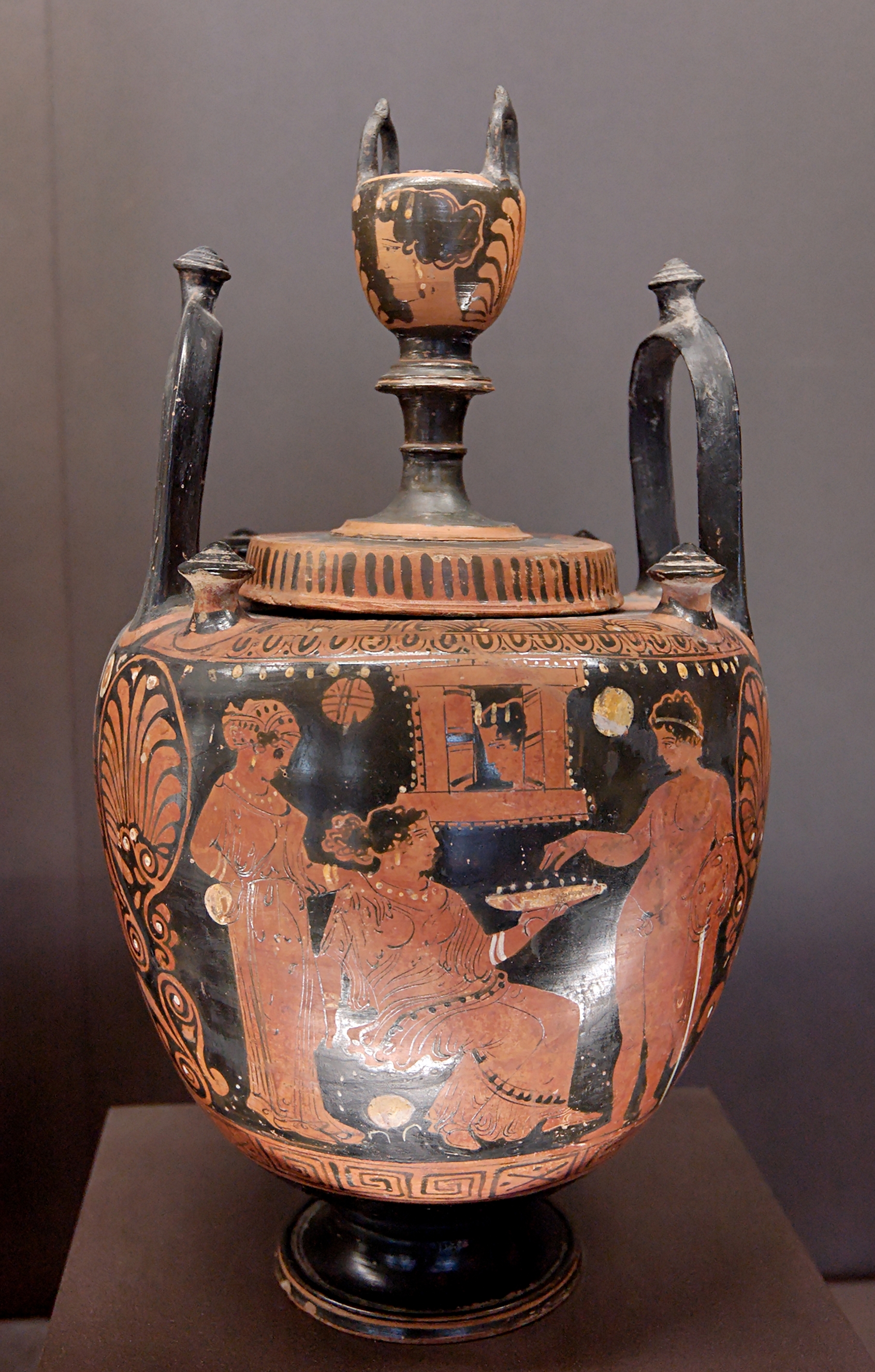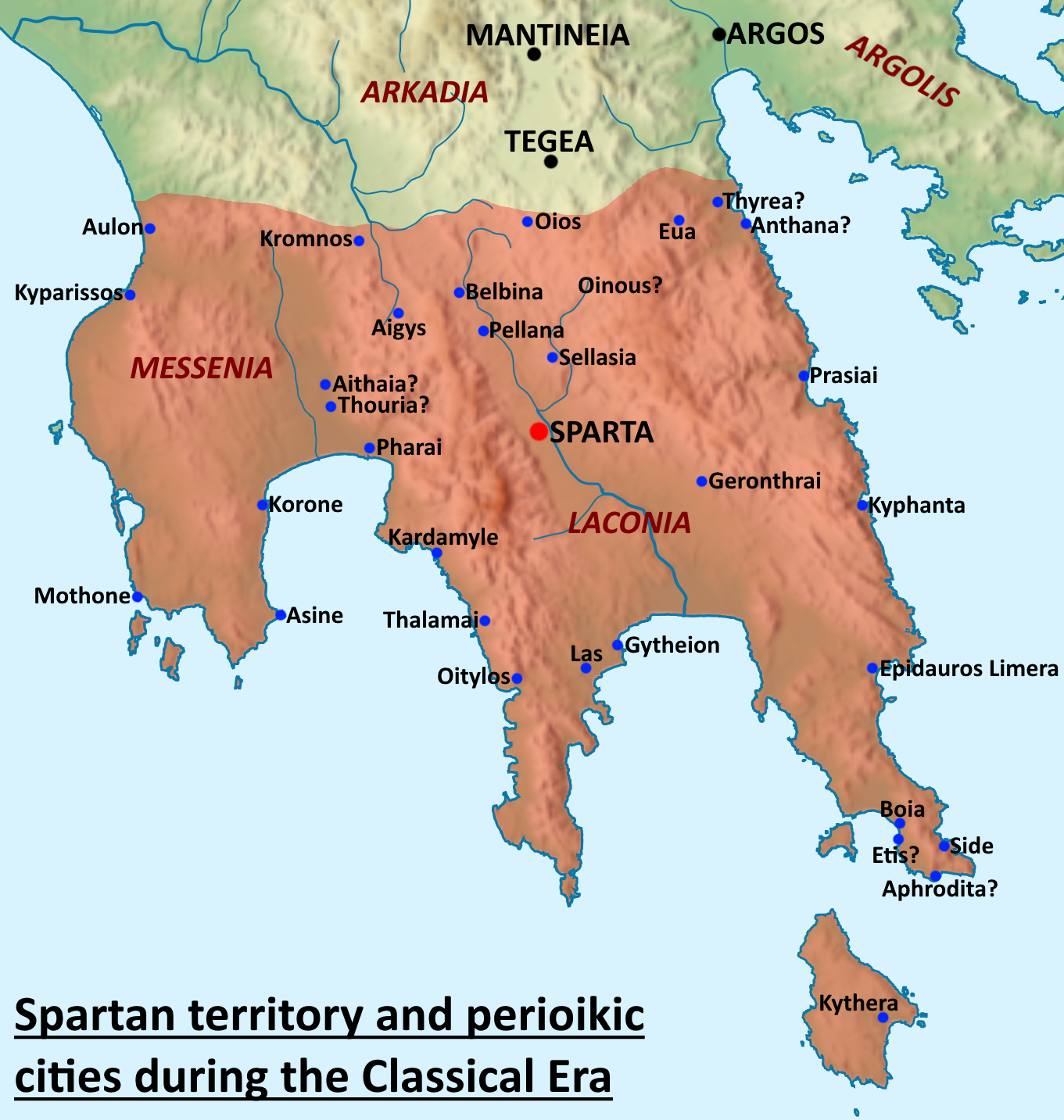|
Rider Painter
The Rider Painter was a Laconian vase painter active between 560 and 530 BC. He is considered one of the five great vase painters of Sparta. His name is unknown, but he is called the Rider Painter after the horseman depicted on his name vase at the British Museum. He painted various shapes, including '' lebetes'', a rare shape in Sparta, but predominantly '' kylikes''. He primarily produced for export, as indicated by the fact that one of his works has so far been discovered in Laconia Laconia or Lakonia ( el, Λακωνία, , ) is a historical and administrative region of Greece located on the southeastern part of the Peloponnese peninsula. Its administrative capital is Sparta. The word ''laconic''—to speak in a blunt, c .... His workshop cannot be located, but was perhaps in a '' perioikic'' settlement. Since identifiable painting styles and peculiarities in vase shapes tend to be consistent, it is assumed that the Rider Painter, like other Laconian vase painters, wa ... [...More Info...] [...Related Items...] OR: [Wikipedia] [Google] [Baidu] |
Rider BM B1
Rider or Riders may refer to: People * Daniel Rider (1938–2008), American mathematician * Fremont Rider (1885–1962), American writer and librarian * George Rider (1890–1979), American college sports coach and administrator * H. Rider Haggard (1856-1925), British novelist * Isaiah Rider (born 1971), American former National Basketball Association player * James Rider (1797–1876), New York politician * Rider Strong (born 1979), American actor, director, producer and screenwriter * Steve Rider (born 1950), English sports presenter and anchorman Law * Rider (legislation), an additional provision attached to a bill * Rider (contract), an additional provision attached to a contract such as an insurance policy * Rider (legal judgement), an explanation appended to a legal decision by a jury or inquest * Rider (theater), a set of requests or demands that a performer will set as criteria for performance Film and TV * ''Steal'' (film), a 2002 action film also known as ''Riders'' * ... [...More Info...] [...Related Items...] OR: [Wikipedia] [Google] [Baidu] |
Laconian Vase Painting
Laconian vase painting is a regional style of Greek vase painting, produced in Laconia, the region of Sparta, primarily in the 6th century BC. The first pottery with ornamental decoration produced in Laconia belongs to the Geometric period. Black-figure Laconian pottery was discovered in considerable amounts in the 19th century, mostly in Etruscan graves. Initially, it was falsely interpreted as produce of Cyrene, where similar material had been found. Thanks to British excavations undertaken since 1906 in the sanctuary of Artemis Orthia at Sparta, the real origin was later recognised. In 1934, Eugene Numa Lane collated the known finds, and became the first archaeologist to distinguish several individual Laconian painters. In 1954, Brian B. Shefton examined new finds. He reduced the number of painters assumed until then by half. The remainder were the Arkesilas Painter, the Hunt Painter and the Rider Painter. In 1958 and 1959, important new finds from Taras were publishe ... [...More Info...] [...Related Items...] OR: [Wikipedia] [Google] [Baidu] |
Sparta
Sparta ( Doric Greek: Σπάρτα, ''Spártā''; Attic Greek: Σπάρτη, ''Spártē'') was a prominent city-state in Laconia, in ancient Greece. In antiquity, the city-state was known as Lacedaemon (, ), while the name Sparta referred to its main settlement on the banks of the Eurotas River in Laconia, in south-eastern Peloponnese. Around 650 BC, it rose to become the dominant military land-power in ancient Greece. Given its military pre-eminence, Sparta was recognized as the leading force of the unified Greek military during the Greco-Persian Wars, in rivalry with the rising naval power of Athens. Sparta was the principal enemy of Athens during the Peloponnesian War (431–404 BC), from which it emerged victorious after the Battle of Aegospotami. The decisive Battle of Leuctra in 371 BC ended the Spartan hegemony, although the city-state maintained its political independence until its forced integration into the Achaean League in 192 BC. The city nevertheless ... [...More Info...] [...Related Items...] OR: [Wikipedia] [Google] [Baidu] |
Name Vase
In classical archaeology, a name vase is a specific "vase"In the study of ancient Greek pottery a "vase" is a general term covering all pottery shapes. whose painter's name is unknown but whose workshop style has been identified. The painter is conventionally named after the selected "name vase" that embodies his characteristic style, or for one of its distinctive painted subjects, or for other attributes. The allocation of such names is necessary because the majority of ancient Greek and South Italian vase painters did not sign their works. For discussion and analysis of the work and career of individual artists conventional names were needed in order to designate them. The name can refer to a vase's motif (the Meleager Painter), former owner (the Shuvalov Painter), present location (the Baltimore Painter), find location (the Dipylon Master), inscription, habitual potter (the Kleophrades Painter), shape, and so on. For Athenian vases, the majority of such names were introduced ... [...More Info...] [...Related Items...] OR: [Wikipedia] [Google] [Baidu] |
British Museum
The British Museum is a public museum dedicated to human history, art and culture located in the Bloomsbury area of London. Its permanent collection of eight million works is among the largest and most comprehensive in existence. It documents the story of human culture from its beginnings to the present.Among the national museums in London, sculpture and decorative and applied art are in the Victoria and Albert Museum; the British Museum houses earlier art, non-Western art, prints and drawings. The National Gallery holds the national collection of Western European art to about 1900, while art of the 20th century on is at Tate Modern. Tate Britain holds British Art from 1500 onwards. Books, manuscripts and many works on paper are in the British Library. There are significant overlaps between the coverage of the various collections. The British Museum was the first public national museum to cover all fields of knowledge. The museum was established in 1753, largely b ... [...More Info...] [...Related Items...] OR: [Wikipedia] [Google] [Baidu] |
Lebes
The lebes (Greek 'λέβης', plural ''lebetes'') is a type of ancient Greek cauldron, normally in bronze. It is a deep bowl with a rounded bottom. It was often supported by a sacrificial tripod. In classical times, a foot was attached and it was typically used as a cooking pot. Variants Tripod lebes The tripod lebes is characterized by two round vertical handles and by three strut-supported legs. All were separately cast then riveted to the cauldron. Artefactual evidence indicates the tripod lebes was not used as a mixing bowl, even long after it lost its role as a cooking pot. Lebes gamikos The lebes gamikos (pl. lebetes gamikoi), or ''nuptial lebes'', appears to have been a part of pre-wedding purification ceremonies, and was often made in pottery. It may have stood by the bride's door and was probably used in ritual sprinkling of the bride with water. Lebetes gamikoi stood on variously long or short bases and each typically was painted with a scene of a wedding procession ... [...More Info...] [...Related Items...] OR: [Wikipedia] [Google] [Baidu] |
Kylix (drinking Cup)
In the pottery of ancient Greece, a kylix ( , ; grc, κύλιξ, pl. κύλικες; also spelled cylix; pl.: kylikes , ) is the most common type of wine-drinking cup. It has a broad, relatively shallow, body raised on a stem from a foot and usually two horizontal handles disposed symmetrically. The main alternative wine-cup shape was the ''kantharos'', with a narrower and deeper cup and high vertical handles. The almost flat interior circle of the base of the cup, called the tondo, was generally the primary surface for painted decoration in the black-figure or red-figure pottery styles of the 6th and 5th century BC, and the outside was also often painted. As the representations would be covered with wine, the scenes would only be revealed in stages as the wine was drained. They were often designed with this in mind, with scenes created so that they would surprise or titillate the drinker as they were revealed. Etymology The word comes from the Greek ''kylix'' ("cup"), ... [...More Info...] [...Related Items...] OR: [Wikipedia] [Google] [Baidu] |
Laconia
Laconia or Lakonia ( el, Λακωνία, , ) is a historical and administrative region of Greece located on the southeastern part of the Peloponnese peninsula. Its administrative capital is Sparta. The word ''laconic''—to speak in a blunt, concise way—is derived from the name of this region, a reference to the ancient Spartans who were renowned for their verbal austerity and blunt, often pithy remarks. Geography Laconia is bordered by Messenia to the west and Arcadia to the north and is surrounded by the Myrtoan Sea to the east and by the Laconian Gulf and the Mediterranean Sea to the south. It encompasses Cape Malea and Cape Tainaron and a large part of the Mani Peninsula. The Mani Peninsula is in the west region of Laconia. The islands of Kythira and Antikythera lie to the south, but they administratively belong to the Attica regional unit of islands. The island, Elafonisos, situated between the Laconian mainland and Kythira, is part of Laconia. The Eurotas is the lon ... [...More Info...] [...Related Items...] OR: [Wikipedia] [Google] [Baidu] |
Perioikoi
The Perioeci or Perioikoi (, ) were the second-tier citizens of the ''polis'' of Sparta until 200 BC. They lived in several dozen cities within Spartan territories (mostly Laconia and Messenia), which were dependent on Sparta. The ''perioeci'' only had political rights in their own city, while the course of the Spartan state exclusively belonged to Spartan citizens, or Spartiates. The name ''perioeci'' roughly means "those dwelling around/nearby", deriving from , ''peri'', "around", and , ''oîkos'', "dwelling, house". ''Perioeci'' and Spartans were collectively called the ''Lakedaimonians''. They had a central role in the Spartan economy, controlling commerce and business, as well as being responsible for crafts and manufacturing, including producing the weapons and armour of the Spartan army, as the higher-ranking Spartan citizens considered all commercial and money-making activities to be unworthy of them. The ''perioeci'' were also the only people allowed to freely travel ... [...More Info...] [...Related Items...] OR: [Wikipedia] [Google] [Baidu] |
Greek Mythology
A major branch of classical mythology, Greek mythology is the body of myths originally told by the Ancient Greece, ancient Greeks, and a genre of Ancient Greek folklore. These stories concern the Cosmogony, origin and Cosmology#Metaphysical cosmology, nature of the world, the lives and activities of List of Greek mythological figures, deities, Greek hero cult, heroes, and List of Greek mythological creatures, mythological creatures, and the origins and significance of the ancient Greeks' own cult (religious practice), cult and ritual practices. Modern scholars study the myths to shed light on the religious and political institutions of ancient Greece, and to better understand the nature of myth-making itself. The Greek myths were initially propagated in an oral tradition, oral-poetic tradition most likely by Minoan civilization, Minoan and Mycenaean Greece, Mycenaean singers starting in the 18th century BC; eventually the myths of the heroes of the Trojan War and its after ... [...More Info...] [...Related Items...] OR: [Wikipedia] [Google] [Baidu] |
Polyphemus
Polyphemus (; grc-gre, Πολύφημος, Polyphēmos, ; la, Polyphēmus ) is the one-eyed giant son of Poseidon and Thoosa in Greek mythology, one of the Cyclopes described in Homer's ''Odyssey''. His name means "abounding in songs and legends". Polyphemus first appeared as a savage man-eating giant in the ninth book of the ''Odyssey''. The satyr play of Euripides is dependent on this episode apart from one detail; Polyphemus is made a pederast in the play. Later Classical writers presented him in their poems as heterosexual and linked his name with the nymph Galatea. Often he was portrayed as unsuccessful in these, and as unaware of his disproportionate size and musical failings. In the work of even later authors, however, he is presented as both a successful lover and skilled musician. From the Renaissance on, art and literature reflect all of these interpretations of the giant. Odysseus and Polyphemus Ancient sources In Homer's epic, Odysseus lands on the island of the ... [...More Info...] [...Related Items...] OR: [Wikipedia] [Google] [Baidu] |
Kadmos
In Greek mythology, Cadmus (; grc-gre, Κάδμος, Kádmos) was the legendary Phoenician founder of Boeotian Thebes. He was the first Greek hero and, alongside Perseus and Bellerophon, the greatest hero and slayer of monsters before the days of Heracles. Commonly stated to be a prince of Phoenicia, the son of king Agenor and queen Telephassa of Tyre, the brother of Phoenix, Cilix and Europa, Cadmus could trace his origins back to Zeus. Originally, he was sent by his royal parents to seek out and escort his sister Europa back to Tyre after she was abducted from the shores of Phoenicia by Zeus. In early accounts, Cadmus and Europa were instead the children of Phoenix.Scholia on Homer, ''Iliad'' B, 494, p. 80, 43 ed. Bekk. as cited in Hellanicus' ''Boeotica'' Cadmus founded the Greek city of Thebes, the acropolis of which was originally named ''Cadmeia'' in his honour. Cadmus' homeland was the subject of significant disagreement among ancient authors. Apollodorus identif ... [...More Info...] [...Related Items...] OR: [Wikipedia] [Google] [Baidu] |





.jpg)



